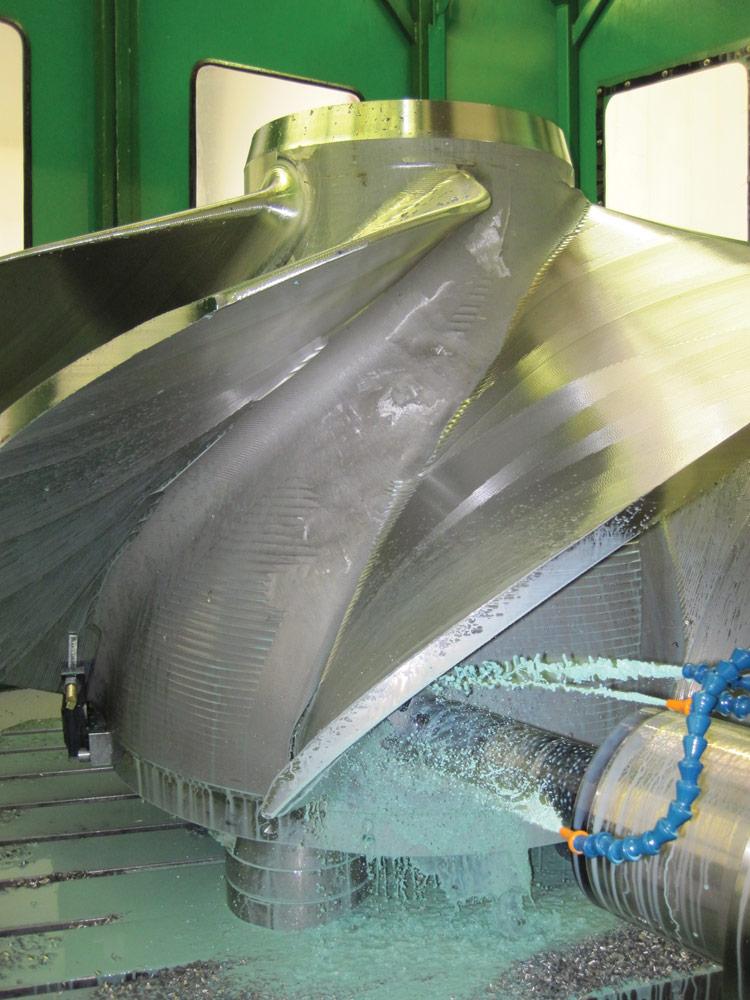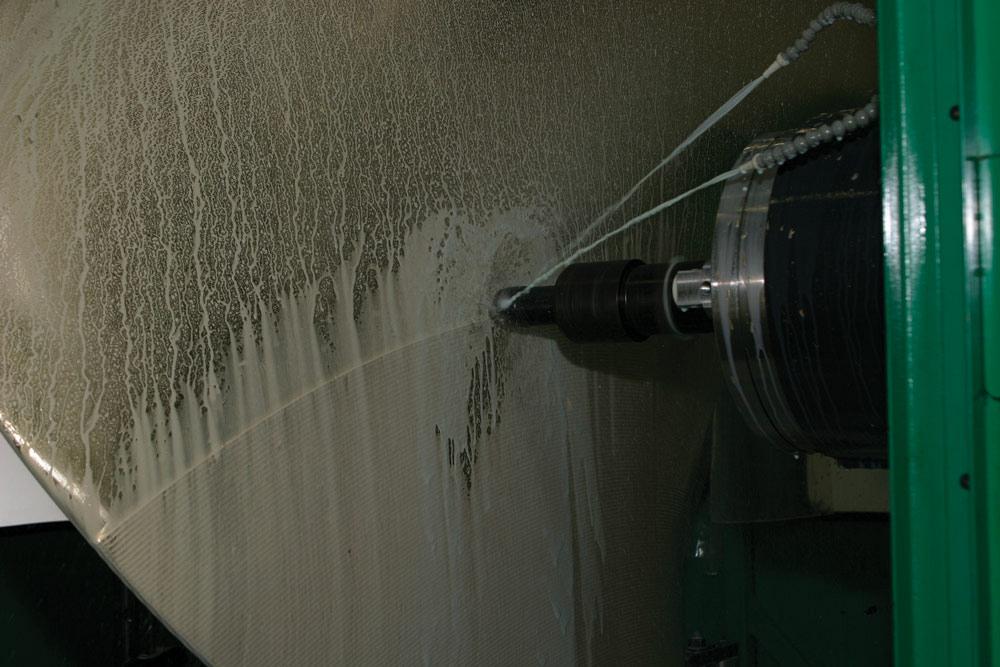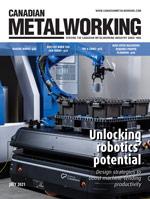Associate Editor
- FMA
- The Fabricator
- FABTECH
- Canadian Metalworking
Dominis Engineering makes waves
Machine shop develops technology to CNC mill high-precision propellers to final form and finish
- By Lindsay Luminoso
- July 19, 2021
- Article
- Made In Canada

This Canadian Patrol propeller blade is manufactured using Dominis’ high-precision CNC machining process. Images: Dominis Engineering Ltd.
Building a large ship requires a significant amount of engineering and manufacturing time. All components need to be designed to ensure that the ship can traverse the water with ease, racking up millions of miles of travel, while being fast and efficient enough to get from port to port. One of the most challenging components to manufacture on any ship, and more specifically large warships and naval vessels, is the propeller.
There are many different scales of ship propellers. The larger and heavier the ship, the more propulsion will be needed to move it. Since the early 1800s propellers have been a regular part of marine and naval manufacturing. However, the manufacturing methods have changed significantly over the years.
Ship propellers traditionally are made by hand by skilled craftsmen who build patterns, manufacture templates, and produce shapes used for imprinting a mould to cast a rough propeller.
The designer then uses mathematical expression to wrap, pitch, skew, and rake the 2D model of the drawing. Once the propeller is rough-cast, it is placed on a drilling machine where an operator drills holes to the exact position of the surface of the finished propeller.
After these holes are in place, an operator then can start grinding off excess material around the holes until they disappear, giving the desired surface finish. This method, however, can include only a limited number of holes in a cylindrical section, leaving gaps in the section for the operator to skillfully finish to specification. Even with the latest CAD/CAM software, it sometimes is difficult to ensure a smooth and continuous surface through these sections.
All excess material needs to be ground off the surface of the blade until smooth, which is traditionally identified by touch. Any distortions or irregularities between sections can spell disaster for the overall effectiveness of the propeller and lead to problems with efficiency, cavitation, and noise.
Most of the work traditionally is done using manual methods, which can be very time-consuming and often messy. The skill needed to perfect these precision components is not always available, either.
Today’s ship propellers, typically manufactured to meet the ISO 484 tolerance standards, still require significant manual processes to get them from start to finish. They generally are finish-ground manually from castings that have been rough-machined on CNC milling machines. But manual and even robotic grinding of propeller surfaces still can lead to inaccuracies and deviations from the design.
With advancements in the technology, CNC milling has become an option for producing these components, but can these machines replicate an experienced person’s skill, precision, and expertise?
Dominis Engineering
This has been the question on Bodo Gospodnetic’s mind for the greater part of 35 years. He worked at the Communications Research Centre in Ottawa. His father Drasko retired from the National Research Council’s ship laboratory in 1985 and was awarded a title of researcher emeritus of the NRC for his pioneering work in CNC milling of ship models. That same year the duo decided to focus their attention on developing a repeatable and automated process to manufacture large, high-precision propellers better.

The shop produces propellers and impellers in various materials, including nickel-aluminum bronze, several different types of stainless steel (316L, CA6NM), and duplex stainless (ASTM A890 grade 4A).
"There are a lot of things you can do on a CNC milling machine, but it was not always obvious that you could completely machine a propeller," said Bodo Gospodnetic, president, Dominis Engineering Ltd., Ottawa, Ont. "Our goal was to write a process that creates steps to show how we can completely machine a propeller on a CNC milling machine. One of the big challenges is that propellers are sculpted surfaces, meaning they are non-analytically defined surfaces. They are defined by discrete points in space. You have to interpolate between those points in space to create a surface. And the surface over the propeller has to be smooth as far as the roughness is concerned, but it also has to be smooth as far as geometry is concerned. This means there can be no bumps, inflection points, or discontinuities on that surface. That’s why we decided to develop our own interpolation schemes, where we can smooth the surfaces and prepare them for complete CNC milling. Then we also developed some special tools that would allow us to machine the surfaces fast."
The initial step was to build a 3D computer model of the entire propeller geometry, not just the cylindrical sections.
Dominis uses proprietary in-house software to interpolate and check all propeller blade sections. A smooth propeller blade is important not just for performance, but also for the ability to machine it, as a bumpy surface can wreak havoc when creating a CNC machining program. The software has the capability to identify bumps and discontinuities and correct them to improve the blade section, while also verifying the propeller blade’s performance.
Once father and son developed their proprietary software and tools, they decided to purchase their first milling machine in 1990 and set up shop in Ottawa.
One of the shop’s first jobs was producing blades for a German hydroturbine and propeller company with a facility in Montreal. Since then Dominis has expanded its shop floor and equipment to include five CNC milling machines, both 4- and 5- axis with rotary on rotary setups rather than 2-axis rotary swivel heads.
Dominis has taken on a range of projects, including propeller blades for changes to Canadian patrol frigates, waterjet impellers for littoral combat ships by Lockheed Martin, monoblock propellers for the Egyptian Navy fast missile craft and Canadian Coast Guard, and propellers for three U.S. Navy programs.
Research and Development
Gospodnetic said that one of the big challenges the company has faced is finding the necessary capital to develop and experiment with the advanced technology and processes needed to CNC mill a propeller from start to finish. As a small shop with about 15 people, Dominis is competing with multinational corporations and has found that focusing on research and development has given it access to grants and funding to bring this idea to fruition.
"We have had a lot of success because we have focused on research and development," said Gospodnetic. "At the same time, we’ve also had help from Industry Canada through the Defence Industry Productivity Program, Technology Partnership Canada, and lately the Strategic Aerospace and Defence Initiative. We are currently working on a research project in co-operation with DRDC-Atlantic, Memorial University, with funding from Transport Canada to determine the impact of manufacturing tolerances on propulsive and cavitation performance of propellers. This has been something that I wanted to examine for a long time. It will help demonstrate that a little nick on the leading edge of the blade—for example, only a 0.5-mm-deep nick on a 4.5-metre-diameter propeller—will make a huge difference in the performance."
Dominis is leading the charge to prove that even the smallest deviations can greatly impact propeller performance, which is why the company has spent so much of its time removing any variables and manual work from the production of its propellers.
"Little nicks or deviations in the form of the leading edge of the propeller blade will cause it to start cavitating," he said. "It will start cavitation before its designed point because the initial form in the design has not been respected, which will then lead to noise. When the propeller starts cavitating, noise will be produced in the water, which could be very dangerous for Naval ships, but it’s also potentially devastating for marine life like orcas and dolphins, which can become disoriented from the noise."

A blade is machined by processing small individual sections on both faces before moving to the next section starting from the tip and working all the way down to thicker sections of the material at the base.
Transport Canada has a fairly large interest in mitigating the noise, especially on the West Coast where orca whale populations have been slowly disappearing.
Manufacturing Today
Although Dominis has been actively researching and developing the latest technology for the greater part of 35 years, Gospodnetic still considers it to be a small company and the only company that actually manufactures large, high-precision propeller blades in Canada.
The shop produces propellers and impellers in various materials, including nickel-aluminum bronze, several different types of stainless steel (316L, CA6NM), and duplex stainless (ASTM A890 grade 4A). Gospodnetic noted that there is a significant gap in machinability from bronze to duplex stainless, which happens to be very challenging to mill. The "final form and finish" technology the shop has developed can be applied to all types of material, regardless of their hardness and machinability.
"Our focus has been to reduce the human intervention in the process and eventually completely eliminate it," said Gospodnetic. "We want to be able to just start the process and walk away. We aren’t quite there yet, but that’s the goal."
Gospodnetic added that the larger the propeller, the more difficult it can be to just walk away because of the sheer amount of CNC milling that needs to be done. And this is especially true when these large pieces are in duplex steel or difficult-to-machine materials. The inserts don’t last long, and even with automatic tool change or automatic cut, substitution doesn’t work well on sculpted surfaces. More human intervention is needed when producing these components.
"Substituting an insert works well on round and flat surfaces," he said. "But on sculpted surfaces, it’s not that easy. After you change the tool, you must remeasure the cutter and recompute the program with these new variables. Without this step, you most likely will need to do some hand finishing and blending afterwards, which we try to avoid."
When Dominis opened, very few shops were using CNC milling machines for any process. Most propellers were completely manually fit to templates, rough-machined, and robotically ground. But even robotic grinding of the edges can be problematic.
The leading and trailing edges of the propellers are the most important feature of the part. The tip is hand-fitted to the two templates, but robots generally can grind only flat areas and have difficulties grinding curved surfaces. Manually grinding the leading and trailing edges is not repeatable and is error-prone. This is why Dominis set out to develop a process that produces propellers from castings using CNC milling to final form and finish.
Cutting speed is extremely important when it comes to producing high-precision propellers. The cutting speed is determined by many different factors such as size and type of cutter, rotational speed of the cutter, material type, shape of the section, and other desired effects that can be used to create the necessary machining program to produce the features of any given blade.
Dominis uses special fixtures that fit under the blades to hold them in place that also can be turned 180 degrees to machine on the opposite face. Any error in the blade rotation can cause the two faces to be mismatched, which may require the propeller to be reworked or, depending on the severity, scrapped.

According to Dominis, its proprietary process creates propellers that are significantly more accurate than ISO 484 Class S tolerances.
The blade is machined by processing small individual sections on both faces before moving to the next section. This method ensures maximum strength of the blade and reduces the chance of bending, starting from the tip and working all the way down to thicker sections of the material at the base.
At the shop the propeller blades can be machined 24 hours per day under direct supervision. Depending on the scale and size of a project, it can take up to two weeks to produce a blade and several more weeks for multiple blades to be completed.
"The idea initially was to take a difficult process that not very many people can do and develop a new process and technology to totally automate manufacturing of propellers," said Gospodnetic. "Propellers and rotating components are a special segment or niche process because their surfaces, which are in contact with water, are non-analytically defined surfaces. That complicates things. And while some people are satisfied with making things to meet the tolerances needed, we want to see how far we can push the envelope to increase the precision because it really matters in the overall performance."
Dominis Engineering, www.dominis.ca
About the Author

Lindsay Luminoso
1154 Warden Avenue
Toronto, M1R 0A1 Canada
Lindsay Luminoso, associate editor, contributes to both Canadian Metalworking and Canadian Fabricating & Welding. She worked as an associate editor/web editor, at Canadian Metalworking from 2014-2016 and was most recently an associate editor at Design Engineering.
Luminoso has a bachelor of arts from Carleton University, a bachelor of education from Ottawa University, and a graduate certificate in book, magazine, and digital publishing from Centennial College.
subscribe now


Keep up to date with the latest news, events, and technology for all things metal from our pair of monthly magazines written specifically for Canadian manufacturers!
Start Your Free Subscription- Industry Events
Automate 2024
- May 6 - 9, 2024
- Chicago, IL
ANCA Open House
- May 7 - 8, 2024
- Wixom, MI
17th annual Joint Open House
- May 8 - 9, 2024
- Oakville and Mississauga, ON Canada
MME Saskatoon
- May 28, 2024
- Saskatoon, SK Canada
CME's Health & Safety Symposium for Manufacturers
- May 29, 2024
- Mississauga, ON Canada




















